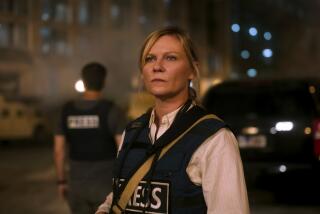Review: ‘Fury’ treads on war movie expectations as Brad Pitt & Co. kill Nazis

Kenneth Turan reviews ‘Fury,’ starring Brad Pitt, Shia LaBeouf, Logan Lerman. Video by Jason H. Neubert.
If memorable war movies mean something to you, open that book to a new page and add “Fury” to the list. It belongs there.
Even if you’re not keeping a list, it’s hard not to be impressed by what writer-director David Ayer, powerfully aided by star Brad Pitt and an exceptional below-the-line team, has accomplished with this bleak and savage story of a World War II tank crew operating in Germany during the last month of the European war.
The advance spin on “Fury” has been, in the words of one of its producers, that it’s “not your grandfather’s war movie.” Like most hype, that turns out to be only half true. In fact, what makes this film distinctive is the adroit way it both subverts and enhances old-school expectations, grafting a completely modern sensibility onto thoroughly traditional material.
For though they don’t necessarily act in expected ways, the five-person cross-section-of-humanity tank crew headed by Pitt’s Sgt. Don Collier, a.k.a. Wardaddy, fits squarely into familiar Hollywood models involving men doing what men have to do because no one’s going to do it but them.
This concern with codes of masculine behavior fits squarely into the preoccupations of filmmaker Ayer, who wrote and directed the LAPD drama “End of Watch.” Before that, he wrote the “Training Day” script that won Denzel Washington an Oscar as well as co-wrote the underappreciated World War II submarine epic “U-571.”
A bear for research, Ayer has apparently been working on this story for years, and under the command of skilled production designer Andrew Menzies, “Fury” shows great concern for getting the specific details right, even rounding up five authentic M4 Sherman tanks and one German Tiger to use in the production.
That passion for getting close to physical reality leads to “Fury’s” most modern aspect, its emphasis on the gory and extreme violence the men ferociously inflict and absorb and how that experience affects them. In some ways, “Fury,” sharply edited by Dody Dorn, plays out as if the astonishing Omaha Beach slaughter that opened “Saving Private Ryan” had characterized an entire film.
With that as grounding, Ayer, working with fluid cinematographer Roman Vasyanov, has felt free to engage in a kind of mythologizing. Yes, the men of Sgt. Collins’ tank are driven by deadening blood lust and not “greatest generation” morality as they exult in frenzied violence, but there is also an underlying and inevitable heroic tone. Those looking for the hipster jokiness that characterized Quentin Tarantino’s “Inglourious Basterds” may well not be happy here.
Set over an action-packed 24 hours in April 1945, “Fury” starts with a sudden move by Sgt. Collins that brutally ends the life of a German officer. As played by Pitt with a white sidewalls haircut and an air of exhausted charisma, the sergeant is very much an enigma, a lone wolf who is a law unto himself. The actor’s stardom is “Fury’s” core advantage: We are hard-wired to be on his team no matter how far beyond the pale his actions go.
In some intangible way, the men who share this tank with the sergeant (who’s occasionally called “Top,” perhaps in tribute to Burt Lancaster in “From Here to Eternity”) feel it is the force of his will that has kept those of them still alive safe and sound. That, and their unquenchable zeal for killing.
These men include gunner Boyd Swan (a surprisingly effective Shia LaBeouf), a born again type who prays over Germans after he kills them; loader Grady “Coon-Ass” Travis (Jon Bernthal), the team’s most atavistic member; and driver Trini Garcia (“End of Watch” veteran Michael Peña.) Like siblings in a dysfunctional family, these men are committed to the group but needle each other something fierce.
Because the tank’s fifth crew member, the assistant driver, has just been killed, new guy Norman Ellison (Logan Lerman) joins the group. He is not just a new guy, he is practically an infant, in the Army just eight weeks and trained to be a clerk typist. He is not happy to be where he is, and the rest of the crew are not happy to have him there.
This is not so much because of his inexperience as his scruples, the fact that he does not understand, as the other men, especially the sergeant, do, that wholesale bloodshed is to be the order of the day and that avoiding it endangers not only his life but those of the rest of the men.
As the tank heads out on a bloody series of missions, it will be the business of Sgt. Collins to educate this young audience surrogate, to make him believe that “we’re not here for right and wrong. You kill him or he kills you.” Or, as he puts it more poetically, “ideals are peaceful. History is violent.”
Along with realism about the violence, one of the themes of “Fury” is not only that people are capable of horrors — “Wait till you see what a man can do to another man,” Boyd tells Norman early on — but also that individuals can come to tolerate if not relish the process. “Best job I ever had” is one of the catchphrases the men in this killing machine use with each other, and the ghastly thing is they half believe it’s true.
------------
‘Fury’
MPAA rating: R, for strong sequences of war violence, some grisly images, and language throughout.
Running time: 2 hours, 14 minutes
Playing: In general release
More to Read
Only good movies
Get the Indie Focus newsletter, Mark Olsen's weekly guide to the world of cinema.
You may occasionally receive promotional content from the Los Angeles Times.







